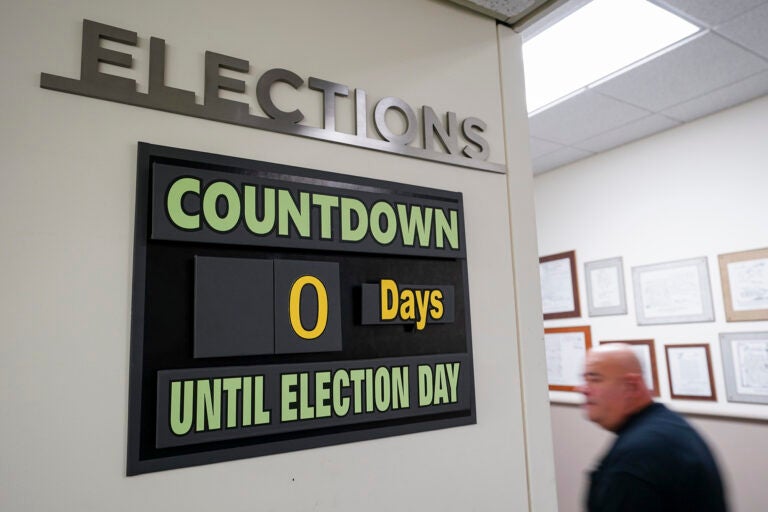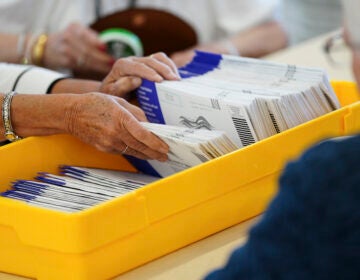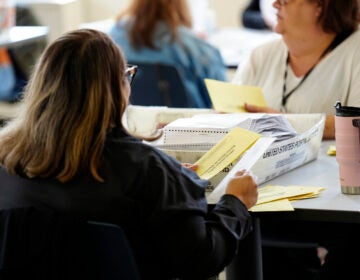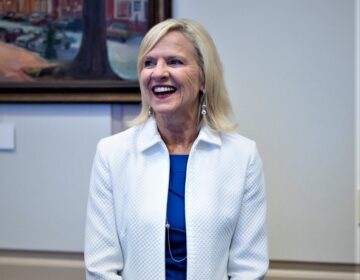Elections 101: How decentralized election administration makes big fraud basically impossible
Experts say claims of stolen elections don’t square with the reality that election administration in the commonwealth is local and decentralized.

A sign displayed in the hallway April 23, 2024, at Northampton County Courthouse in Easton, Northampton County, Pennsylvania. (Matt Smith / For Spotlight PA)
This story originally appeared on Spotlight PA.
At the heart of former President Donald Trump’s false claim that the 2020 election was stolen from him is a fundamental misunderstanding of how elections work in Pennsylvania.
Such massive fraud involving thousands of stolen votes would need to be witnessed here by members of both major parties in public spaces.
To the election directors working on the ground, claims of stolen elections underline how little is known about the process. Thad Hall, election director in Mercer County, told Spotlight PA that theories about broad collusion to alter results just don’t square with the reality that election administration in the commonwealth is local and decentralized.
“When you claim that mail ballots were mishandled or something like that, the people that would do that would be residents of Mercer County,” Hall said. “You’re suggesting that a lot of different people from both political parties were involved. It’s your neighbors, your friends.”
Pennsylvania’s system of election administration can be broken into three levels: the Department of State, county-level officials, and poll workers on the ground.
Each layer of administration safeguards against fraud in different ways. The Department of State maintains the voter registration database used across the commonwealth. County election officials oversee the storage and testing of voting machines. Poll workers monitor activities at polling precincts to ensure that voters are casting their ballots correctly.
The state sets guardrails
While each of the state’s 67 counties can set different policies for conducting elections — like whether to use drop boxes or allow voters to fix mistakes on mail ballots — some overarching rules are set by state law and legal precedent.
The basic administrative framework is laid out in Pennsylvania’s Election Code. It includes requirements for things like the number of polling places and poll workers and the times when polls should open and close. The code is old, however, and hasn’t had a comprehensive update since 1937. While new provisions have been added, like no-excuse mail voting, it still contains outdated, irrelevant language and contradictions that election administrators must navigate.
To do that, they also rely on court rulings, seek advice from county solicitors, and consult with other county election directors to determine best practices.
The Department of State also issues guidance on best practices in areas where Pennsylvania law is vague.
Another key election administration responsibility for the state is managing the voter registration database, which tracks eligible voters. The state also certifies the final results of the election.
However, many administration and decision-making responsibilities lie with counties.
County administrators have a lot of autonomy
Pennsylvania counties have a board of elections and an election director. The board and director, as well as the county solicitor, decide how to interpret Pennsylvania’s old code when there are conflicts.
Election directors are generally selected by their county’s board of elections and come from a variety of backgrounds. While some who have served in the role in recent years came from other administrative local government roles, others were funeral home owners, educators, and nurses.
These directors handle the day-to-day work of running elections and oversee the canvassing process, wherein poll workers sort and count ballots. They locate polling places, make sure there are enough poll workers for each precinct, and organize the printing of ballots. In preparation for Election Day, directors also test voting machines and secure them in a safe location where they cannot be tampered with.
Boards of elections oversee this work and collaborate with directors to make major policy decisions.
In most of Pennsylvania, elected county commissioners serve on election boards. Counties with home rule charters can use a different process to pick members. The Election Code requires each board of elections to feature representation from a minority political party, based on the composition of the county commissioners.
The board is empowered to make critical decisions such as whether to use mail ballot drop boxes or allow voters to correct flawed mail ballots before Election Day. That’s an important responsibility, since there are ill-defined areas within the guardrails of the state’s Election Code, legal precedents, and directives that the board must clarify.
The passage of Act 77 in 2019 raised the stakes. The law allows all voters to use mail ballots, but it’s silent on many issues, including drop boxes. So far, state lawmakers have not agreed on legislation that would fill in those details.
This has led to disparate practices across the state, which can result in some voters having more opportunities to ensure their vote is counted than others, depending on the county in which they live.
Poll workers are the boots on the ground
Several types of poll workers in Pennsylvania help ensure that voting goes smoothly on Election Day.
The lead election officer in a voting precinct is known as the judge of elections. This person manages any problem that might arise at the polling place — like running out of ballots or a voting machine malfunction — and alerts the county election director. They are also responsible for tracking numbers of voters, and for returning ballots and materials to the county election director at the end of the night.
This is an elected position with a four-year term, though a county board of elections can also appoint someone to the role if there is a vacancy.
Each precinct also has a majority and minority inspector in charge of managing pollbooks — which contain voter registration info to sign in voters — and aiding the judge of elections. Each of those positions is elected every four years, with the highest vote-getter becoming the majority inspector and the person with the second most votes serving as the minority inspector. These positions can be appointed if there is a vacancy, or if no one runs.
Poll workers are volunteers who set up voting machines, sign in voters, and give instructions.
In 2022, the state had about 9,000 different polling places and nearly 50,000 poll workers. Almost anyone can apply to be a poll worker — though government officials and employees are banned — so long as they are registered to vote in the county where they want to work. Counties also pay poll workers, though wages vary.
Before Election Day, all poll workers go through training either virtually or in person.
 Spotlight PA is an independent, nonpartisan, and nonprofit newsroom producing investigative and public-service journalism that holds the powerful to account and drives positive change in Pennsylvania.
Spotlight PA is an independent, nonpartisan, and nonprofit newsroom producing investigative and public-service journalism that holds the powerful to account and drives positive change in Pennsylvania.

Get daily updates from WHYY News!
WHYY is your source for fact-based, in-depth journalism and information. As a nonprofit organization, we rely on financial support from readers like you. Please give today.







